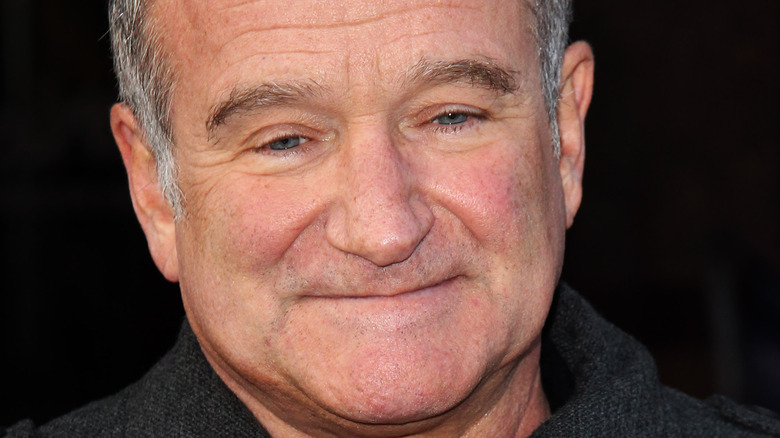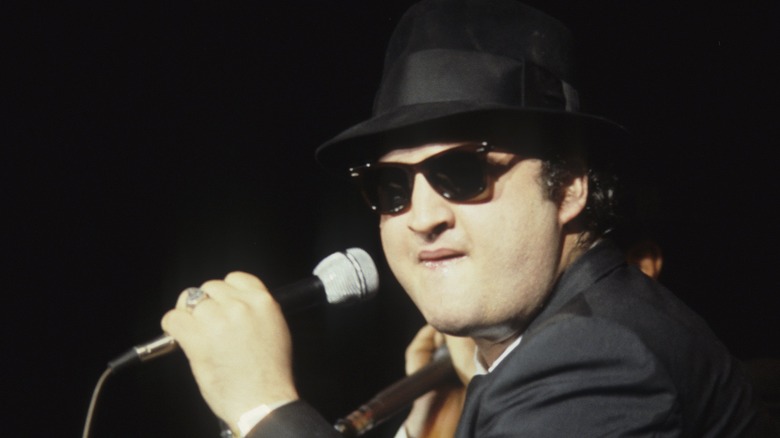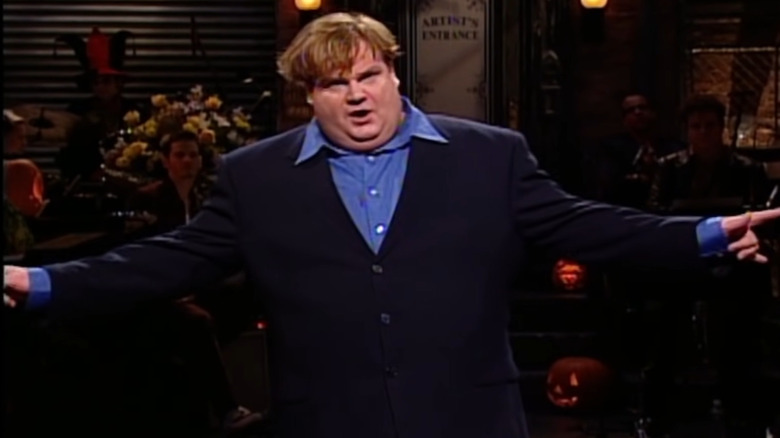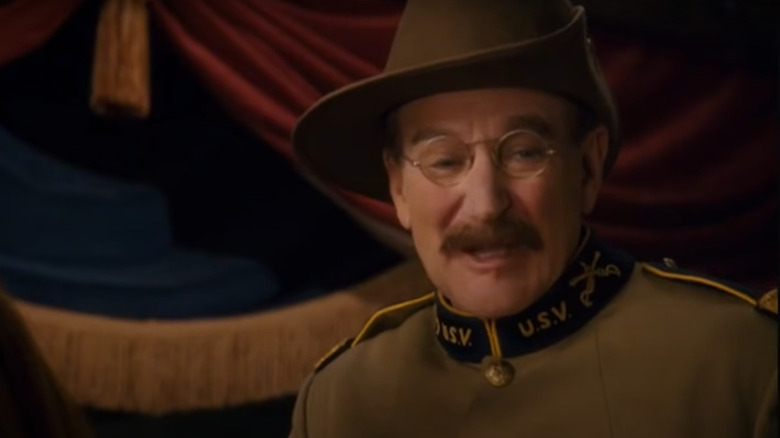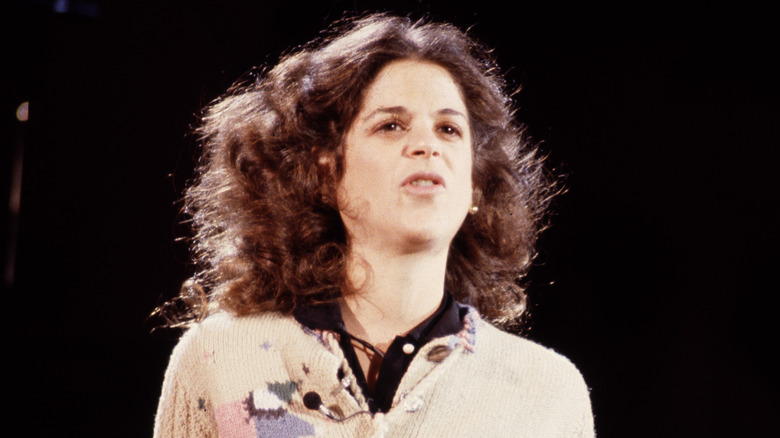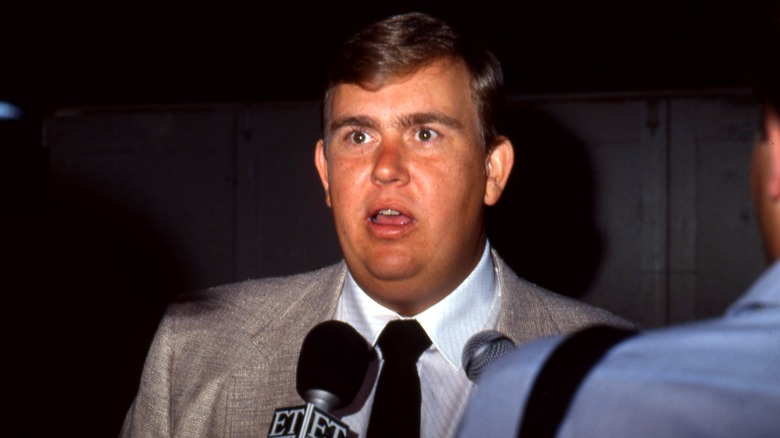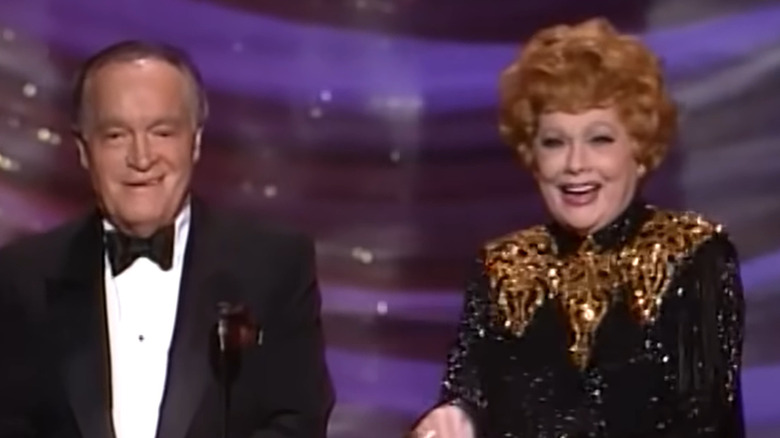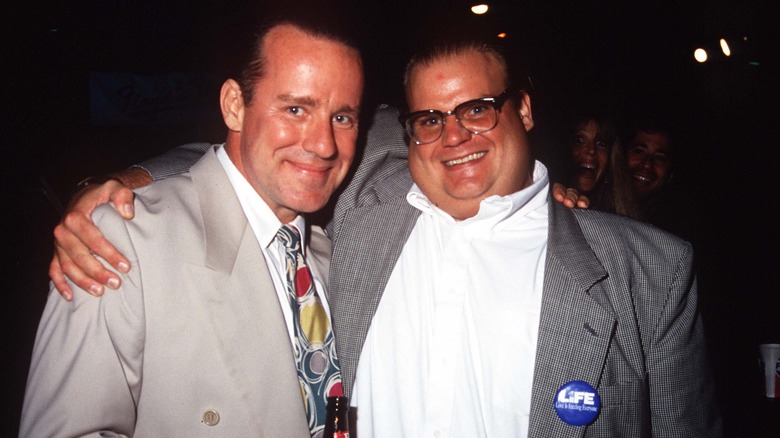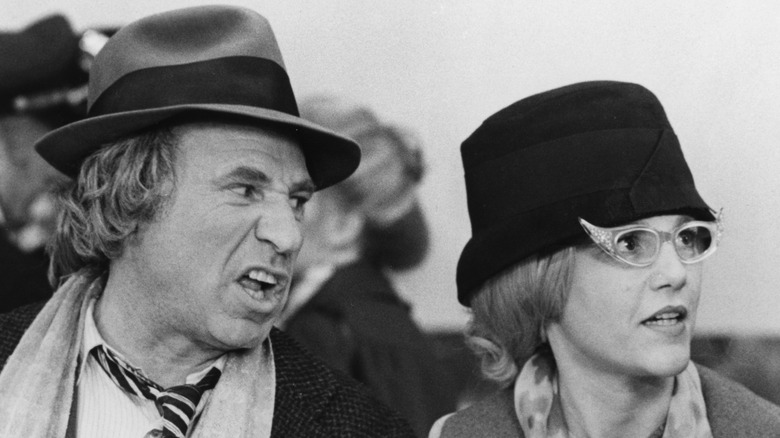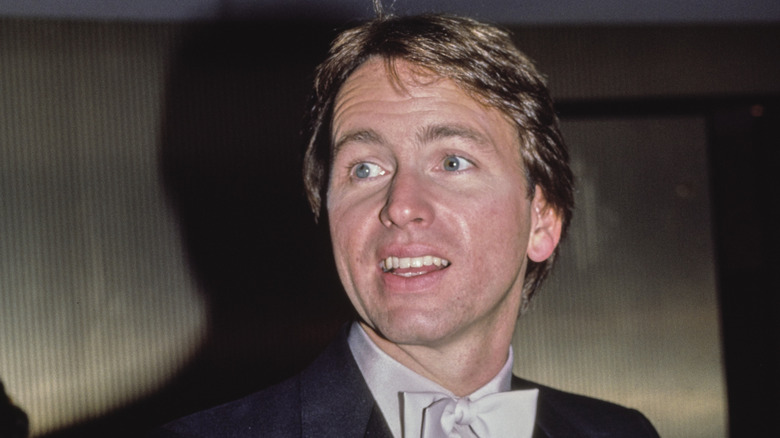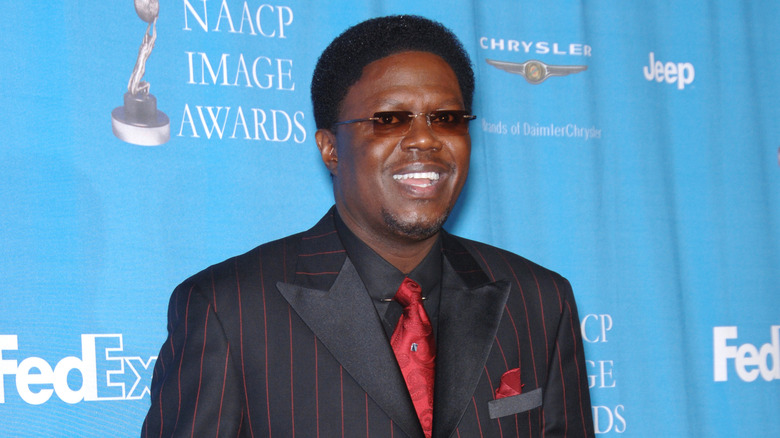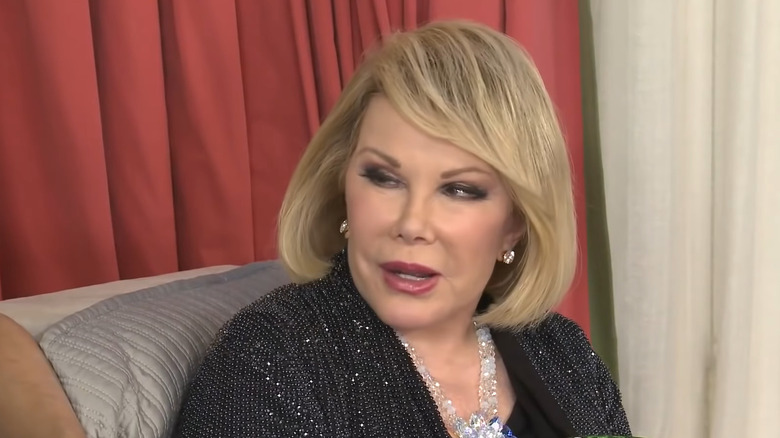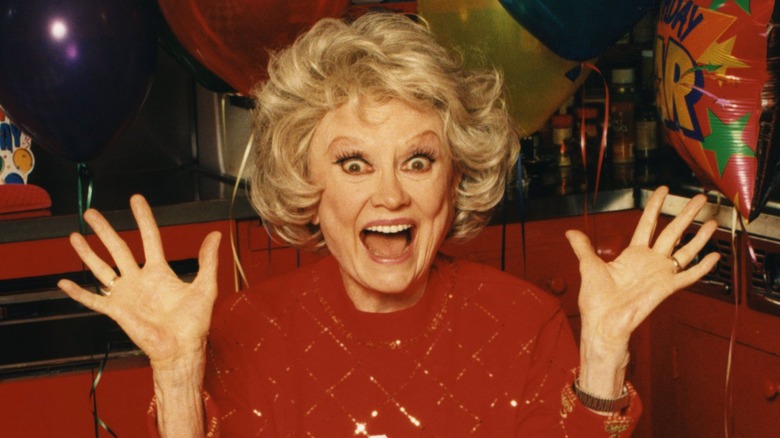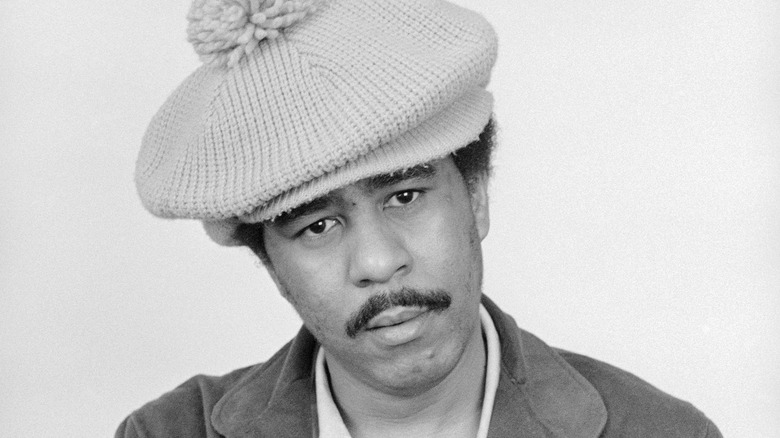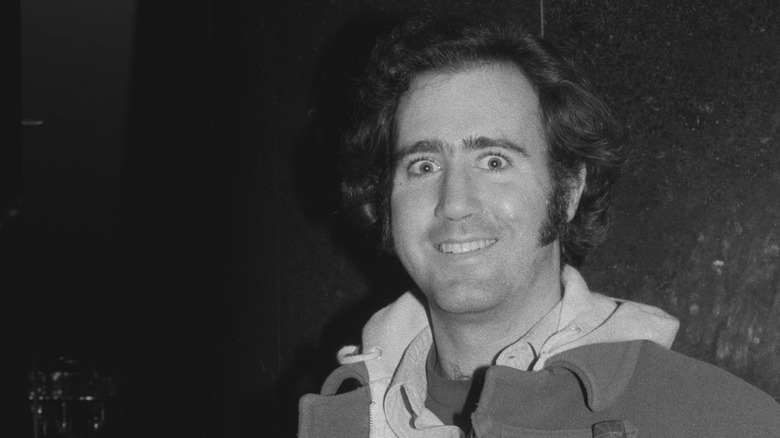The Last Time These Comedy Geniuses Were Seen On Camera Before They Died
The following article includes references to suicide, addiction, and domestic violence.
While comedy, writ large, is certainly not an American invention, stand-up comedy just might be. Slate reports that historians have traced the origins of stand-up comedy to the vaudeville and burlesque theaters in turn-of-the-century New York. According to the outlet, the shows that took place in these halls were fast-paced, physically explosive, and full of slapstick humor and a hefty dose of poking fun at the-powers-that-be.
The first stand-up comedian, Charley Case, was a Black vaudeville star who performed his acts without any costuming or props. While little is known about his life today, a few of his jokes are still drifting around in various articles and books, including one that goes like this: "I think there's a burglar loose in the house, you should go down and find him." Response: "I haven't lost a burglar, make [someone else] go down." In 1916, Case died in the Palace Hotel in NYC, "while cleaning his revolver."
Case's life, and work, set the stage for many of our favorite modern-day comedians, several of whom also got their start in stand-up. And, just like Case, we've lost many of them much too soon, sometimes in tragic circumstances. Here, we've rounded up a list of 14 comedy geniuses we've lost, focusing on the last time they were seen on camera before their deaths. From Robin Williams to Richard Pryor, get ready to cry as much as you laugh.
John Belushi died of a drug overdose
John Belushi first tried out his manic, sarcastic comedy style in a Chicago-area, anti-establishment coffee house in 1969. Shortly after that first appearance, he was invited to join The Second City, a Chicago-based improvisation troupe that's trained the likes of Steve Carell and Amy Poehler. But it wasn't until 1975, when Lorne Michaels offered him a spot on his new sketch comedy series called "Saturday Night Live," that Belushi became known to wider audiences.
Belushi spent four seasons on the series, leaving in 1979 at the height of his popularity –- Vulture reports he had the no. 1 film, no. 1 late-night show, and no. 1 album in 1978 -– to begin a string of film projects with fellow cast member Dan Aykroyd, including mega-hits like "The Blues Brothers" and "Neighbors" (Aykroyd also wrote "Ghostbusters" for Belushi, according to USA Today, but he died before production began). Other notable films on his resume include the classic "National Lampoon's Animal House" and the Steven Spielberg flop "1941."
In 1982, Belushi was found dead at the Chateau Marmont from a drug overdose. He was 33. His last publicly released on-screen appearance was in the film "Neighbors," which had come out just three months prior to his death. However, the last project he ever filmed was an episode of "Police Squad!" Unfortunately for fans, his scene was cut before the episode aired, and the footage has either been lost or completely destroyed.
If you or anyone you know is struggling with addiction issues, help is available. Visit the Substance Abuse and Mental Health Services Administration website or contact SAMHSA's National Helpline at 1-800-662-HELP (4357).
Chris Farley last appeared on Saturday Night Live
Chris Farley and John Belushi had eerily similar lives, careers, and fates. Both midwesterners, Farley and Belushi got their start in the Chicago branch of The Second City, would go on to be "SNL" cast members, and would die at the age of 33 from drug overdoses. They also shared an edgy style of comedy, that more prudish audiences were quick to dismiss as inappropriate.
Farley, who joined the "SNL" cast in 1990, eight years after Belushi's death, frequently collaborated with fellow castmates Chris Rock, Adam Sandler, Tim Meadows, and David Spade, forming a clique that would come to be known as "the bad boys of SNL." It was this group of funnymen that would help Farley bring some of his best-known characters — like Matt Foley, the over-the-top motivational speaker — to life. After "SNL," Farley would go on to star in movies like "Airheads," "Tommy Boy," and "Black Sheep."
Following his death in 1997, Farley had two films hit theaters, "Dirty Work" and "Almost Heroes," neither of which was very successful (one critic for the Chicago Tribune called "Almost Heroes" "a sad swan song"). However, both of those films were completed months before his death, making his final on-screen appearance the October 25, 1997 episode of "SNL" which he hosted.
If you or anyone you know is struggling with addiction issues, help is available. Visit the Substance Abuse and Mental Health Services Administration website or contact SAMHSA's National Helpline at 1-800-662-HELP (4357).
Robin Williams' final role was as Teddy Roosevelt
Robin Williams broke into the stand-up comedy scene in San Francisco back in the 1970s, according to the "Stand Up List." He performed at many of the Bay Area's biggest clubs, perfecting his irreverent, lightning-quick, and quippy style as well as his impeccable impressions of everyone from heads of state to cartoon characters. In 1977, he made his first TV appearance on an episode of "Laugh-In" and released his first special, "Off the Wall," a year later. From there, Williams went on to land a starring role on "Mork & Mindy," and the rest, as they say, is history.
Over the course of his decades-long career, Williams starred in a number of box-office hits like "Aladdin," "Good Morning, Vietnam," and "Mrs. Doubtfire," proving along the way that he also had a serious side in projects like "Goodwill Hunting" and "Dead Poets Society." Then, in 2014, the seemingly happy-go-lucky, Academy Award-winning actor shocked the world when he died by suicide. It would later be revealed that he had been struggling with Lewy Body dementia (which had been misdiagnosed as Parkinson's disease).
At the time of his death, Williams had several unreleased projects, including "Night at the Museum: Secret of the Tomb," which would be his final on-screen appearance (as museum exhibit Teddy Roosevelt come to life). The film's director, Shawn Levy, told USA Today, "It's tremendously, poignantly ironic that the movie's central theme is about letting go of something you love. I never expected it would also be about letting go of this actor we all love."
If you or anyone you know is having suicidal thoughts, please call the National Suicide Prevention Lifeline at 1-800-273-TALK (8255).
Gilda Radner appeared on Garry Shandling's show
The queen of character comedy, Gilda Radner was the first cast member creator Lorne Michaels signed to "Saturday Night Live." Michaels, who had seen Radner's work with the improv troupe The Second City and on "The National Lampoon Show," told The New York Times of the comedian: "I felt there was a remarkable quality to her, a goodness which came through whatever she was doing." She spent five years on the series, writing many of her own skits and creating iconic characters like Roseanne Roseannadanna, Baba Wawa, and Emily Litella (she took home an Emmy for her efforts in 1978).
Radner also spent quite a bit of time in the theater. She got her first taste of show business in a Toronto production of "Godspell," and apparently enjoyed it so much she elected to do two other stage productions: a one-woman Broadway show called "Gilda Live" and a traveling play called "Lunch Hour." However, her thriving career came to an abrupt halt in 1986 when she was diagnosed with stage IV ovarian cancer.
Her last on-screen appearance was as a guest star on buddy Garry Shandling's sitcom, "It's Garry Shandling's Show." The 1988 episode was filmed just months before she found out that the cancer, which had been in remission for some time, had returned. She spoke to The Washington Post about the experience, saying, "It was my first time going back on television, and I gotta tell you, I loved it. I was soooo happy. Once I got there, I couldn't get enough. I wasn't worried about myself physically or healthwise." A little over a year after the episode aired, Radner died of ovarian cancer.
John Candy died from a heart attack
Yet another comedian with ties to The Second City, John Candy honed his comedic timing in the Toronto branch's training program before landing a spot on its "Second City Television" series (which was, essentially, Canada's answer to "SNL"). He won two Emmy Awards for his work on the series between 1981-1983, including one for writing his most iconic character, Yosh Shmenge, a clarinet player in a polka band. These awards opened doors for him in Hollywood, and he was quickly cast in a number of successful films like "Splash," "Uncle Buck," "Planes, Trains, and Automobiles," and "Cool Runnings."
During his lifetime, much was made of his physical appearance -– he was 6'3" and often weighed in excess of 275 pounds -– with many critics and journalists maintaining, as The New York Times wrote, "his girth was a key to his appeal on film." At the time of his death, in 1994, the New York Daily News reported that he actually weighed more than 350 pounds. It is believed that his size was a factor in the heart attack that led to his death at the age of 43.
When he died, Candy was actually in the midst of shooting his final film, "Wagons East!" The movie, which was finished with the use of stunt doubles and special effects, was a critical flop, with the Los Angeles Times declaring it not worthy of a career kicker. Perhaps somewhat confusingly, the last John Candy film to ever be released, 1995's "Canadian Bacon," had actually been completed in 1993, four months before Candy's death.
Lucille Ball attended the Oscars before her death
A woman ahead of her time, Lucille Ball was the star of her own show, a studio executive, and a producer at a time when the best many women could hope for was a decent role in someone else's project. She began her career as a contract player at RKO, taking bit parts and roles in B movies, before throwing all her energy into a TV pilot idea she developed alongside her husband, Desi Arnaz. It took CBS some convincing to pick up the show, but once they did, "I Love Lucy" became an overnight success, with millions of Americans tuning in to watch each week.
A national institution, Ball's comedy style was born from an impeccable sense of timing, an incredible ability to pantomime, and a gift for making even the most outrageous scenarios feel believable for her audience. In 1938, The New York Times wrote that Ball "is rapidly becoming one of our brightest comediennes." She continued to spread that brightness right up to her death in 1989.
Ball's last scripted on-screen appearance was in an episode of "Life with Lucy," an ill-fated reboot of the "I Love Lucy" franchise that lasted for only eight episodes. But her true last on-screen appearance was at the televised 1989 Oscars, where she appeared alongside Bob Hope to introduce a song-and-dance segment called "The Stars of Tomorrow." Clips of the telecast, which aired just one month before her death, can still be found online.
Phil Hartman's last appearance was in 1998
A funny man by nature, Phil Hartman began to hone the more technical aspects of his comedy routine when he joined The Groundlings, a California-based improv group. The story goes like this: Hartman was in the audience at one of their shows and was invited up on stage to participate. Accepting the invitation, he almost immediately stole the show. Tracy Newman, a founder of the group, told ABC News, "I never saw an audience member come up with that kind of excitement and energy ... it was like a hurricane hit that stage, and I mean in a good way."
It wasn't long until Hartman joined the cast of "SNL" (where he earned a reputation for his impersonations of public figures like Bill Clinton and Liberace), followed by roles on the sitcom "News Radio" and "The Simpsons." While his professional life was flourishing, his personal life wasn't faring quite as well. By 1987, he was on his third marriage, to model Brynn Omdahl, and things were not all that happy in paradise. Omdahl reportedly was struggling with substance addiction, and, according to accounts given to the L.A. Times, had trouble controlling her temper. In May 1998, Hartman died in a murder-suicide perpetrated by his wife.
The last time Hartman physically appeared on-screen was on a 1998 episode of "3rd Rock from the Sun" called "Eat, Drink, Dick, Mary." However, his last project to ever be released was an episode of "Happily Ever After: Fairy Tales for Every Child," where he lent his voice to a character simply credited as Game Show Host.
If you or someone you know is dealing with domestic abuse, you can call the National Domestic Violence Hotline at 1−800−799−7233. You can also find more information, resources, and support at their website.
Madeline Kahn died in 1999
In the early 1970s, Tony Award-winning actress Madeline Kahn made the jump from Broadway shows to the movies, and comedy was never the same. Her star rose with stage musicals like Leonard Sillman's "New Faces of 1968," "Two by Two" and "On the Twentieth Century." But she really became a household name with the release of films like "What's Up, Doc?," "Paper Moon," "Blazing Saddles," "Young Frankenstein," and "High Anxiety."
Much of her intuitive comedic technique has been attributed to the cartoonish way she spoke. Mel Brooks, who directed three of Kahn's most famous films, told The New York Times, "She is one of the most talented people that ever lived. I mean, either in stand-up comedy, or acting, or whatever you want, you can't beat Madeline Kahn." Then, in 1999, shortly after finishing a voiceover role in "A Bug's Life," Khan was diagnosed with ovarian cancer, dying in December of that year.
Her last project was an indie movie called "Judy Berlin." Given the budget of the film, it didn't receive as much publicity or attention as Kahn's previous projects. Still, critics from outlets like "All Movie" generally praised her performance as "lend[ing] the proceedings a funny, infectious sense of wonder" as a "loopy" mom.
John Ritter experienced problems on set
Don Knotts once called John Ritter "the greatest physical comedian on the planet," according to the Hollywood Walk of Fame. Born into a Hollywood dynasty (his father was the singing cowboy Tex Ritter, and his mother, Dorothy Fay, was a Westerns actress), Ritter's connections helped him land his first role in the Disney film "The Barefoot Executive." Then, in 1977, he really made it big when he landed a starring role on the sitcom "Three's Company," which the Chicago Tribune credits with bringing "a new level of risque humor to TV."
The success of the series helped Ritter land more than 100 roles in TV series, films, and stage productions, from 1990's Stephen King miniseries "It" to his final live-action film "Bad Santa." At the time of his death, he was working on his second successful sitcom, "8 Simple Rules," which wrote his death into the plot and carried on for another full season. In fact, it was on the set of this series, in 2003, where he first began to experience chest pains, before being transported to a hospital and dying of an undetected heart problem.
A number of Ritter's projects were released posthumously, including several episodes of "Clifford the Big Red Dog" (he voiced the oversized pup in the PBS animated series), several episodes of both "8 Simple Rules" and "King of the Hill" (he voiced Eugene Grandy), and his final movie "Bad Santa." The very last of these projects to be released was an animated children's movie called "Stanley's Dinosaur Round-up," which came out in 2006.
Bernie Mac was last seen in Old Dogs
Born and raised on the south side of Chicago, Bernie Mac didn't have the same sort of easy, cushy start as many of his contemporaries, whose relative privilege allowed them to focus more fully on comedy and offered them entry into the country's more exclusive improv groups. Instead, he only dabbled in the art form while plugging away at various jobs and performing at clubs where, as he told The Washington Post, "didn't nobody else want to work. I had to do clubs where street gangs were, had to do motorcycle gangs ... and things of that nature."
Eventually, his work paid off. He began to win comedy contests, was invited to perform at two shows with Def Comedy Jam, and began winning small roles in a variety of movies. It was "The Original Kings of Comedy" tour (which included D.L. Hughley, Steve Harvey, and Cedric the Entertainer), as well as the Spike Lee film of the same name, that really made him a star. A stint on "Moesha" and then his own series, "The Bernie Mac Show," quickly followed. But it all came to an end in 2008 when Mac died of complications from pneumonia that stemmed from his sarcoidosis disease, as reported by People Magazine.
His final on-screen appearance was in a movie called "Old Dogs" that also starred John Travolta and Robin Williams. Bernie Mac played a children's puppeteer in the film which has been tactfully described as "chaos" by the Times. The film was released in 2009.
Joan Rivers entertained from her bed
Joan Rivers was one of comedy's most divisive figures -– you either loved her or you hated her. Her sharp, acerbic style certainly wasn't for everyone, but it did help her become a pioneer for women in comedy and made her, as one New York Times critic put it, "the most intuitively funny woman alive."
From stand-up routines in Greenwich Village comedy clubs to her breakthrough appearance on "The Tonight Show," guest-starring spots on network sitcoms, her own series like the ill-fated "The Late Night Show with Joan Rivers" or the daytime "The Joan Rivers Show," and her red carpet hosting partnership with E!, Rivers never lost her edge or gave in to the pressure to tone her voice down. She also never lost her urge to work, saying "yes" to seemingly every project that came her way, from QVC clothing and jewelry lines to commercials and sponsorships to book deals. She worked all the way up until the age of 81, when, in September 2014, she died following complications stemming from a routine outpatient surgery.
Her final on-camera appearance was in an episode of her web series "In Bed With Joan." Hosting the show from her literal bed, Rivers would engage in no-holds-barred conversations with some of the biggest celebrities and comedians of the era. The guest of that final episode, which aired just weeks before Rivers' death, was Bianca Del Rio.
Phyllis Diller's last appearance was as herself
Unlike other comedians who began their careers fresh out of college or in their early 20s, Phyllis Diller didn't get her start until the age of 37. Still, from her first performance, in a San Francisco comedy club in 1955 to her last on a 2012 episode of "The Bold and Beautiful," Diller earned more laughs than other comics who started at half her age. Her self-deprecating style and over-the-top appearance helped her shine in a time when very few female comics were finding success in the stand-up scene.
Diller shared a close friendship with Bob Hope (who once described her as "a Warhol mobile of spare parts picked up along a freeway," according to The Guardian), and the two worked together on several films including "Boy, Did I Get a Wrong Number!" Diller also released a number of comedy albums, had her own variety show called "The Beautiful Phyllis Diller Show" on NBC, did a run on Broadway in "Hello Dolly!," took guest roles on a number of popular sitcoms, and lent her voice to a host of animated series. In 2012, CNN reported that Diller "died peacefully in her sleep" at the age of 95, as related by her manager.
According to Entertainment Weekly, her final on-screen appearance wasn't as a character or even the stand-up caricature she'd crafted over the years, but as herself on a 2013 episode of Bravo's "Dukes of Melrose" reality show. During the episode, host Cameron Silver quipped that Diller's closet "represents a life well lived ... and shopped."
Richard Pryor died of a heart attack
One of the biggest and most influential stand-up comedians of all time, who, according to The New York Times, "transcended barriers of race" to bring his particular brand of comedy to the world, Richard Pryor had a career that spanned four decades. He got his start performing in New York comedy clubs, before being offered guest spots on late-night shows and tours in Las Vegas. Over the next 40 years, he recorded a number of comedy albums, worked as a sitcom writer, and starred in movies like "Silver Streak" and "See No Evil, Hear No Evil."
One thing that set Pryor apart from his fellow comedians was the way he leaned into his cultural identity. He frequently used street slang in his acts and told stories about life as a Black man that included social commentary. Kennen Ivory Wayans told the Times, "Pryor started it all. He made the blueprint for the progressive thinking of Black comedians, unlocking that irreverent style."
In 2005, CNN reported that Pryor, who had been diagnosed with multiple sclerosis years prior, had died of a heart attack. His last on-screen appearance was on the show "Norm," where he appeared in the cold open as a wheelchair-bound elderly man who had been kicked out of his nursing program for hitting the nurses.
Andy Kaufman's last appearance was startling
Although Andy Kaufman hated being called a comedian, it seems almost impossible to classify him as anything else. He once told an interviewer at The New York Times, "I am not a comic, I have never told a joke .... The comedian's promise is that he will go out there and make you laugh with him .... My only promise is that I will try to entertain you as best I can." Still, as Lily Tomlin put it to the same outlet, he "did not have to tell a joke to make someone laugh."
Kaufman's career is a bit harder to trace, as he never had a show of his own and never joined an improv group the way so many of his contemporaries did. Here are the highlights: he is perhaps best known for playing Latka Gravis on "Taxi," he guest-starred on "SNL" a number of times, he got into a (staged?) fight on the Canadian variety show "Fridays," and he dabbled in professional wrestling as the "Inter-Gender Wrestling Champion of the World" for a number of years. His work was often so bizarre and out-there, that when he died of lung cancer in 1984 many of his closest friends assumed it was a hoax.
According to IMDb, Kaufman's last on-screen appearance was in "My Breakfast with Blassie," which fans have declared is "boring." The Los Angeles premiere of the film (parts of which were recorded and can be found online) was Kaufman's last public appearance. In the footage, he sports a mohawk and looks gaunt, which was, perhaps, a side effect of his disease.

